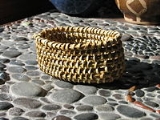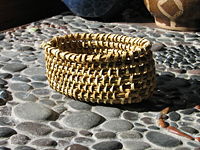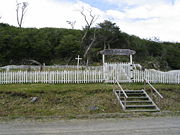
Yaghan
Encyclopedia
The Yaghan, also called Yagán, Yahgan (the original spelling), Yámana or Yamana, are the indigenous inhabitants of the islands south of Isla Grande de Tierra del Fuego
extending their presence into Cape Horn
. They were known as Fuegians
by the English speaking world, but the term is nowadays avoided as it can refer to any of the indigenous peoples of Tierra del Fuego
. They spoke the Yaghan language
which is considered to be a language isolate
. The Yaghan were nomads who traveled by canoe
s between islands to collect food. The men hunted sea lions while the women dove to collect shellfish
.
The Yahgan left strong impressions on all who encountered them, including Ferdinand Magellan
, Charles Darwin
, Francis Drake
, James Cook
, and James Weddell
. In "Sailing Alone Around the World
" Joshua Slocum
was warned they would rob and possibly kill him if he moored in a particular area, so he sprinkled tacks on the deck of his boat, the Spray
.
1) They kept warm by huddling around small fires when they could, including in their boats to stay warm. In fact, the name of "Tierra del Fuego" (land of fire) is a name given to the island cluster by passing European explorers who witnessed these fires burning.
2) They made use of rock formations to shelter themselves from the elements.
3) They covered themselves in animal grease.
4) Over time they had evolved significantly higher metabolisms than average humans, allowing them to generate more internal body heat.
5) Their natural resting position was a deep squatting position, which reduced their surface area and so helped to conserve heat.
waters. They would often sleep in the open completely unsheltered and unclothed while Europeans shivered under their blankets. A Chilean researcher claimed their average body temperature was warmer than a European's by at least one degree.
 Yaghans established many settlements within Tierra del Fuego; for example there is a significant Yaghan archaeological site at Wulaia Bay, which C. Michael Hogan terms the Bahia Wulaia Dome Middens.
Yaghans established many settlements within Tierra del Fuego; for example there is a significant Yaghan archaeological site at Wulaia Bay, which C. Michael Hogan terms the Bahia Wulaia Dome Middens.
But the Yahgan, who never numbered more than 3,000 individuals, could not survive contact with diseases brought by Westerners. They allegedly became sick immediately if the missionaries persuaded them to put on some clothes. In the 1920s some were resettled on Keppel Island
in the Falklands
in an attempt to preserve the tribe, as described by E. Lucas Bridges
in Uttermost Part of the Earth (1948), but continued to die off. The second-to-last full-blooded Yaghan, Emelinda Acuña, died in 2005. The last full-blooded Yahgan is "Abuela" Cristina Calderón
. She is also the last native speaker of the Yahgan language. The Yahgan are considered to be a Mongoloid group who reached the south tip of South America like the Ona people.
 The area around Tierra del Fuego became known to Europeans in the early sixteenth century, but it was not until the nineteenth century that Europeans started to be interested in the zone and its peoples. When Robert FitzRoy
The area around Tierra del Fuego became known to Europeans in the early sixteenth century, but it was not until the nineteenth century that Europeans started to be interested in the zone and its peoples. When Robert FitzRoy
became captain of the HMS Beagle
in the middle of her first voyage, he captured four Fuegians after a boat was stolen. As it was not possible to put them ashore conveniently, he decided to "civilise the savages," teaching them "English..the plainer truths of Christianity..and the use of common tools" before returning them as missionaries. One died, but the others became "civilised" enough to be presented at court in the summer of 1831. On the famous second voyage of HMS Beagle
, the three Fuegians were returned along with a trainee missionary, and impressed Charles Darwin
with their "civilised" behaviour, in startling contrast to the "primitive" tribes he saw once the ship reached Patagonia. He described his first meeting with the native Fuegians as being "without exception the most curious and interesting spectacle I ever beheld: I could not have believed how wide was the difference between savage and civilised man: it is greater than between a wild and domesticated animal, in as much as in man there is a greater power of improvement." In contrast, he said of Jemmy Button
that "It seems yet wonderful to me, when I think over all his many good qualities, that he should have been of the same race, and doubtless partaken of the same character, with the miserable, degraded savages whom we first met here." The mission was set up for the three Fuegians, but when the Beagle returned a year later only Jemmy was found, and he had returned to his tribal ways, speaking English as well as ever and assuring them that he "had not the least wish to return to England" and was "happy and contented" to live in what they thought a shockingly primitive manner with his wife.
Isla Grande de Tierra del Fuego
Isla Grande de Tierra del Fuego is an island near the southern tip of South America from which it is separated by the Strait of Magellan...
extending their presence into Cape Horn
Cape Horn
Cape Horn is the southernmost headland of the Tierra del Fuego archipelago of southern Chile, and is located on the small Hornos Island...
. They were known as Fuegians
Fuegians
Fuegians are the indigenous inhabitants of Tierra del Fuego, at the southern tip of South America. In English, the term originally referred to the Yaghan people of Tierra del Fuego...
by the English speaking world, but the term is nowadays avoided as it can refer to any of the indigenous peoples of Tierra del Fuego
Tierra del Fuego
Tierra del Fuego is an archipelago off the southernmost tip of the South American mainland, across the Strait of Magellan. The archipelago consists of a main island Isla Grande de Tierra del Fuego divided between Chile and Argentina with an area of , and a group of smaller islands including Cape...
. They spoke the Yaghan language
Yaghan language
Yagán , also known as Yámana and Háusi Kúta, is one of the indigenous languages of Tierra del Fuego, spoken by the Yagán people...
which is considered to be a language isolate
Language isolate
A language isolate, in the absolute sense, is a natural language with no demonstrable genealogical relationship with other languages; that is, one that has not been demonstrated to descend from an ancestor common with any other language. They are in effect language families consisting of a single...
. The Yaghan were nomads who traveled by canoe
Canoe
A canoe or Canadian canoe is a small narrow boat, typically human-powered, though it may also be powered by sails or small electric or gas motors. Canoes are usually pointed at both bow and stern and are normally open on top, but can be decked over A canoe (North American English) or Canadian...
s between islands to collect food. The men hunted sea lions while the women dove to collect shellfish
Shellfish
Shellfish is a culinary and fisheries term for exoskeleton-bearing aquatic invertebrates used as food, including various species of molluscs, crustaceans, and echinoderms. Although most kinds of shellfish are harvested from saltwater environments, some kinds are found only in freshwater...
.
The Yahgan left strong impressions on all who encountered them, including Ferdinand Magellan
Ferdinand Magellan
Ferdinand Magellan was a Portuguese explorer. He was born in Sabrosa, in northern Portugal, and served King Charles I of Spain in search of a westward route to the "Spice Islands" ....
, Charles Darwin
Charles Darwin
Charles Robert Darwin FRS was an English naturalist. He established that all species of life have descended over time from common ancestry, and proposed the scientific theory that this branching pattern of evolution resulted from a process that he called natural selection.He published his theory...
, Francis Drake
Francis Drake
Sir Francis Drake, Vice Admiral was an English sea captain, privateer, navigator, slaver, and politician of the Elizabethan era. Elizabeth I of England awarded Drake a knighthood in 1581. He was second-in-command of the English fleet against the Spanish Armada in 1588. He also carried out the...
, James Cook
James Cook
Captain James Cook, FRS, RN was a British explorer, navigator and cartographer who ultimately rose to the rank of captain in the Royal Navy...
, and James Weddell
James Weddell
James Weddell was a British sailor, navigator and seal hunter who in the early Spring of 1823 sailed to latitude of 74°15' S and into a region of the Southern Ocean that later became known as the Weddell Sea.-Early life:He entered the merchant service very...
. In "Sailing Alone Around the World
Sailing Alone Around the World
Sailing Alone Around the World is a sailing memoir by Joshua Slocum about his single-handed global circumnavigation aboard the sloop Spray. Slocum was the first person to sail around the world alone...
" Joshua Slocum
Joshua Slocum
Joshua Slocum was the first man to sail single-handedly around the world. He was a Canadian born, naturalised American seaman and adventurer, and a noted writer. In 1900 he told the story of this in Sailing Alone Around the World...
was warned they would rob and possibly kill him if he moored in a particular area, so he sprinkled tacks on the deck of his boat, the Spray
Spray (sailing vessel)
The S.V. Spray was a oyster sloop rebuilt by Joshua Slocum and used by him to sail single-handed around the world, the first voyage of its kind...
.
Adaptations to climate
The Yahgan did not wear clothes until their contact with Europeans. They were able to survive the harsh climate because:1) They kept warm by huddling around small fires when they could, including in their boats to stay warm. In fact, the name of "Tierra del Fuego" (land of fire) is a name given to the island cluster by passing European explorers who witnessed these fires burning.
2) They made use of rock formations to shelter themselves from the elements.
3) They covered themselves in animal grease.
4) Over time they had evolved significantly higher metabolisms than average humans, allowing them to generate more internal body heat.
5) Their natural resting position was a deep squatting position, which reduced their surface area and so helped to conserve heat.
The early Yaghans
The Yahgan may have been driven to this inhospitable area by enemies to the north, but were famed for their complete indifference to the bitter weather around Cape Horn. Although they had fire and small domed shelters, they routinely went about completely naked in the frigid cold and biting wind of Tierra del Fuego, and swam (women only) in its 48-degree-south48th parallel south
The 48th parallel south is a circle of latitude that is 48 degrees south of the Earth's equatorial plane. It crosses the Atlantic Ocean, the Indian Ocean, the Pacific Ocean and South America....
waters. They would often sleep in the open completely unsheltered and unclothed while Europeans shivered under their blankets. A Chilean researcher claimed their average body temperature was warmer than a European's by at least one degree.

But the Yahgan, who never numbered more than 3,000 individuals, could not survive contact with diseases brought by Westerners. They allegedly became sick immediately if the missionaries persuaded them to put on some clothes. In the 1920s some were resettled on Keppel Island
Keppel Island
Keppel Island is one of the Falkland Islands, lying between Saunders Island and Pebble Island, and near Golding Island to the north of West Falkland on Keppel Sound. It has an area of and its highest point, Mt Keppel, is high. There is a wide, flat valley in the centre of the island with...
in the Falklands
Falkland Islands
The Falkland Islands are an archipelago in the South Atlantic Ocean, located about from the coast of mainland South America. The archipelago consists of East Falkland, West Falkland and 776 lesser islands. The capital, Stanley, is on East Falkland...
in an attempt to preserve the tribe, as described by E. Lucas Bridges
Lucas Bridges
Esteban Lucas Bridges was an Anglo-Argentine author and explorer. He was the third child and second son of Anglican missionary Reverend Thomas Bridges and "the third white native of Ushuaia" at the southernmost tip of South America...
in Uttermost Part of the Earth (1948), but continued to die off. The second-to-last full-blooded Yaghan, Emelinda Acuña, died in 2005. The last full-blooded Yahgan is "Abuela" Cristina Calderón
Cristina Calderón
Cristina Calderón of Robalo, Puerto Williams, on Navarino Island, Chile, is the last living full-blooded Yaghan person. By 2004, Calderón and her sister-in-law Emelinda Acuña were the only two remaining native speakers of the Yaghan language...
. She is also the last native speaker of the Yahgan language. The Yahgan are considered to be a Mongoloid group who reached the south tip of South America like the Ona people.
European contact

Robert FitzRoy
Vice-Admiral Robert FitzRoy RN achieved lasting fame as the captain of HMS Beagle during Charles Darwin's famous voyage, and as a pioneering meteorologist who made accurate weather forecasting a reality...
became captain of the HMS Beagle
HMS Beagle
HMS Beagle was a Cherokee-class 10-gun brig-sloop of the Royal Navy. She was launched on 11 May 1820 from the Woolwich Dockyard on the River Thames, at a cost of £7,803. In July of that year she took part in a fleet review celebrating the coronation of King George IV of the United Kingdom in which...
in the middle of her first voyage, he captured four Fuegians after a boat was stolen. As it was not possible to put them ashore conveniently, he decided to "civilise the savages," teaching them "English..the plainer truths of Christianity..and the use of common tools" before returning them as missionaries. One died, but the others became "civilised" enough to be presented at court in the summer of 1831. On the famous second voyage of HMS Beagle
Second voyage of HMS Beagle
The second voyage of HMS Beagle, from 27 December 1831 to 2 October 1836, was the second survey expedition of HMS Beagle, under captain Robert FitzRoy who had taken over command of the ship on its first voyage after her previous captain committed suicide...
, the three Fuegians were returned along with a trainee missionary, and impressed Charles Darwin
Charles Darwin
Charles Robert Darwin FRS was an English naturalist. He established that all species of life have descended over time from common ancestry, and proposed the scientific theory that this branching pattern of evolution resulted from a process that he called natural selection.He published his theory...
with their "civilised" behaviour, in startling contrast to the "primitive" tribes he saw once the ship reached Patagonia. He described his first meeting with the native Fuegians as being "without exception the most curious and interesting spectacle I ever beheld: I could not have believed how wide was the difference between savage and civilised man: it is greater than between a wild and domesticated animal, in as much as in man there is a greater power of improvement." In contrast, he said of Jemmy Button
Jemmy Button
Orundellico, known as "Jeremy Button" or "Jemmy Button", was a native Fuegian of the Yaghan people from islands around Tierra del Fuego, in modern Chile and Argentina...
that "It seems yet wonderful to me, when I think over all his many good qualities, that he should have been of the same race, and doubtless partaken of the same character, with the miserable, degraded savages whom we first met here." The mission was set up for the three Fuegians, but when the Beagle returned a year later only Jemmy was found, and he had returned to his tribal ways, speaking English as well as ever and assuring them that he "had not the least wish to return to England" and was "happy and contented" to live in what they thought a shockingly primitive manner with his wife.
Famous Yahgans
- York Minster, Fuegia Basket and Jemmy ButtonJemmy ButtonOrundellico, known as "Jeremy Button" or "Jemmy Button", was a native Fuegian of the Yaghan people from islands around Tierra del Fuego, in modern Chile and Argentina...
. All of these names were coined by sailors on the BeagleHMS BeagleHMS Beagle was a Cherokee-class 10-gun brig-sloop of the Royal Navy. She was launched on 11 May 1820 from the Woolwich Dockyard on the River Thames, at a cost of £7,803. In July of that year she took part in a fleet review celebrating the coronation of King George IV of the United Kingdom in which...
during the first voyage. - "Julie" (true name unknown). Pictured at ages 40 and 90, the latter photo taken in 1958. Both pictures are reproduced in the book Evolution.
External links
- The Yahgan
- Dr Wilhelm Koppers: Unter Feuerland-Indianern. Strecker und Schröder, Stuttgart, 1924. (A whole book online. In German. Title means: “Among Fuegians”, but most parts of the book contains Yaghan-related materials. Some chapters presents Selknam people.)
- The Patagonian Canoe. Extracts from the following book. E. Lucas Bridges: Uttermost Part of the Earth. Indians of Tierra del Fuego. 1949, reprinted by Dover Publications, Inc (New York, 1988).
- Darwin, Charles & Fitzroy, Robert & King, Philip Barker: Narrative of the Surveying Voyages of His Majesty's ships Adventure and Beagle, between the years 1826 and 1836, describing their examination of the Southern Shores of South America, and the Beagle's circumnavigation of the Globe. Henry Colburn, London, 1839.
- Felipe, the "Survivor", was the last Male Yagan Indian, with a small Yámana–English vocabulary
- Anne Chapman's European Encounters with the Yamana People of Cape Horn, Before and After Darwin

